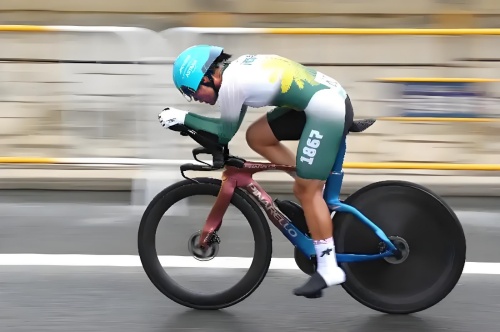new blog
With “Technology + Sports” as its core theme, the 15th National Games of China in 2025 deeply integrates cutting-edge technologies such as composite materials to boost athletic performance while driving sports equipment toward greener and smarter development. With advantages such as lightweight, high strength, and excellent corrosion resistance, composite materials are widely applied in cycling, water sports, athletics, and winter sports, providing a solid technological foundation for athletes to push their limits and for efficient event organization.
This article systematically reviews the practical achievements and breakthrough directions of composite material applications in the 15th National Games from three perspectives: application scenarios, technological innovations, and industry impact.
In the cycling events of the 15th National Games, carbon-fiber composite frames have become the mainstream configuration. A representative example is the XDS racing bike used by Chinese athletes: its frame is built with T1100-grade carbon fiber, weighing only 1150 g, and the complete bike stays under 9.6 kg, placing it among the lightest models in its class worldwide.
The lightweight advantage of carbon fiber effectively reduces athletes’ physical exertion, while its high strength and impact resistance ensure frame stability during high-speed riding. In addition, carbon fiber offers outstanding fatigue resistance — after one million cyclic stress tests, it can still retain 60% of its strength, far exceeding traditional metal materials and significantly extending the service life of the equipment.

Rowing and canoe/kayak events impose stringent requirements on material lightweighting and rigidity. In the 15th National Games, some rowing shells were built using 100% epoxy resin–impregnated unidirectional carbon fiber, achieving a combination of lightness and structural robustness that significantly enhances maneuverability.
The paddle blades widely adopt carbon-fiber or glass-fiber composites. Through an innovative outer-tow design, the blades achieve an ultra-light weight of 470–520 g while maintaining high stiffness. Their grooved structure increases the efficiency of each stroke, enabling athletes to perform more effectively in events such as slalom and sprint.

Pole Vault: Carbon-fiber poles have become the core equipment enabling athletes to push their limits. Their three-layer composite structure — an outer layer of high-strength carbon fiber, a middle layer of carbon-fiber woven tape, and an inner layer of glass fiber — achieves a perfect balance of lightness and flexibility. It is precisely this equipment advantage that has helped legendary athletes such as Bubka and Isinbayeva repeatedly break world records.
Sprinting Events: Starting blocks now incorporate carbon-fiber composites. By simultaneously reducing weight and enhancing stiffness, they effectively improve athletes’ launch speed and force stability during the start.

Although the 15th National Games did not include winter sports, the technological maturity of carbon-fiber composites in this field is already well established. The TG800 carbon-fiber bobsled produced by Shanxi Steeltech employs high-precision, complex structural manufacturing techniques, optimizing its aerodynamic profile while strictly controlling the overall weight, thereby significantly reducing air resistance and enhancing competition performance.
Carbon-fiber bobsled helmets are also customized using 3D reverse modeling and lattice-structured 3D printing, simultaneously meeting the requirements for lightweight design, safety protection, and wearing comfort.
During the 15th National Games, 3D printing emerged as a core breakthrough in the R&D and manufacturing of composite equipment, offering advantages in both customization and efficiency. In functional gear, smart cooling apparel leveraged 3D printing for rapid prototype iteration, combined with miniature compression-based cooling and closed-loop temperature control systems, providing outdoor workers with precisely tailored, personalized cooling solutions.
In structural component manufacturing, breakthroughs in carbon-fiber composite 3D printing enabled the integrated formation of complex structures (such as aerospace-grade parts). This not only significantly improved production efficiency but also enhanced material utilization, laying a foundation for the large-scale application of composite equipment.
The fusion of composites and smart technologies has become a central trend in equipment innovation at the Games. By embedding fiber-optic sensors in rowing paddles, key data such as stroke force and frequency can be collected in real time, providing athletes with precise tactical feedback. Carbon-fiber poles integrate strain sensors, dynamically optimizing energy transfer during takeoff. These innovations not only directly enhance athletic performance but also create a new data platform for sports science research, advancing the scientific development of training methods.
Aligned with the “Green National Games” initiative, the 15th Games promoted the use of low-carbon, environmentally friendly composites. New materials such as biobased carbon fiber and biodegradable resins gradually replaced traditional chemical raw materials, significantly reducing the environmental footprint of sports equipment.
For example, polylactic acid (PLA) materials, produced via microbial cultivation and gypsum-free processes, reduce the consumption of food-based resources while enabling natural degradation. Their lightweight and eco-friendly properties make them suitable for large-scale applications in temporary infrastructure, providing new pathways for the sustainable and green development of sporting events.
The 2025 National Games vividly showcased the powerful synergy of technology and sports, with the widespread application of composite materials as a unifying thread. From the lightweight breakthroughs of carbon-fiber frames and real-time data feedback enabled by smart sensors to the eco-friendly practices of biobased materials, composites not only provide a solid technological foundation for enhancing athletic performance but also guide sports equipment toward sustainable development.
Looking ahead, with the continuous evolution of materials science and smart technologies, composite materials are poised to occupy a central role in the global sports industry, providing robust support for human achievement, pushing the limits of athletic performance, and advancing the principles of green development.